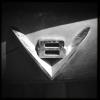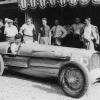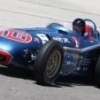Very bad racing cars
#1

Posted 30 December 2005 - 10:41
Anyone else remember the Porter? So bad only one ever made it to a race track, and it was sent home by the scrutineers. A total of six were sold.
The chassis jig was a pair of saw horses. The body mould was a hole in Jack Porter's backyard lined with concrete. The fibreglass bodies actually had indentations from the bits of blue metal in the concrete. The steering wheel was oxy-cut from a piece of steel plate, then trimmed with split garden hose.
Apart from that, it was terrible.
Bruce Moxon
*****************************************************************************
Just found the above gem in the thread about Australian racing car constructors. Quite made my day, that did.
Has there ever been anything else quite so bad that was made as a commercial proposition, rather than as a one-off by some hopeful but misguided individual?
Advertisement
#2

Posted 30 December 2005 - 10:54
I once heard it said that somebody buying a Nota had to take it away and redo all the welds if they wanted it to stay in one piece.
#3

Posted 30 December 2005 - 11:15
#4

Posted 30 December 2005 - 11:19
I can think of some pretty dire 'customer cars' - the first Lola F3000 for example, little more than a Champcar with a DFV in the back... or the one '85 Reynard FFord that Wiet Huidekoper did - not a bad car, the concepts were developed elsewhere into a very good one IIRC... but they're occasional 'drop the ball' moments by otherwise reputable marques rather than desperate chancers producing absolute toilets.
#5

Posted 30 December 2005 - 11:54
There I was at Le Mans in 1993. Watched this monster negotiating the Ford chicane. I then took a break for some merguez and chips and a plastic demi of Kronenbourg. Popped into the ACO shop to buy yet another mini FM radio (I always forget to take one) and then wandered up to the Dunlop bridge after a "rest" break in that funny loo under the ACO stand..imagine my surprise to find that I had beaten the MIG there.
#6

Posted 30 December 2005 - 17:15
There was another sportscar in the late 1990s - early 2000s that was as bad as the MiG/Monte Carlo/Whateverisitsnamethisweek: the Banshee. It came back in a Grand Am race at Road America, where Janos Wimpffen expressed total amazement that somebody would actually be willing to sit in it, let alone drive it...
#7

Posted 30 December 2005 - 19:46
Anyone else know more about this one?
#8

Posted 30 December 2005 - 20:03
A few more that have to go in, on those criteria:
F1:
Maki
1993 and 1997 Lolas
Coloni-Subaru
Andrea Moda S291 (good but old design, badly built?)
Pacific PR01 (Reynard F3000 floorsweepings in Benetton-alike bodywork)
BRM P207
F2:
Chevron-Ferrari (with the original works sump!)
Sports cars:
"Eagle" - the one that started life as a Lola "Corvette GTP" and acquired the very big engine!
Sthemo
ROC
Norma-MGN
#9

Posted 30 December 2005 - 20:13
#10

Posted 30 December 2005 - 20:36
#11

Posted 30 December 2005 - 20:55
#12

Posted 30 December 2005 - 21:14
The Antares Manta
'nuff said.
#13

Posted 30 December 2005 - 23:01
Crosleys with the tin engine?
Anton
#14

Posted 30 December 2005 - 23:29
#15

Posted 31 December 2005 - 05:47

Had a second fuel tank between engine and gearbox. A total no-hoper.
Happy NY to all other TNFers!
#16

Posted 31 December 2005 - 18:09
#17

Posted 31 December 2005 - 18:48
Originally posted by jj2728
First one that comes to mind is the Honker IIRC....a can-am car of which Mario Andretti was not all that fond of.....please feel free to correct me if I got the name wrong.
The official title of the thing was Honker II, I think Honker I was John Holman of entrants on behalf of Ford, Nascar specialists Holman-Moody. The ungainly beast was designed by Len Bailey and built by in the UK by Alan Mann, and had an H-M tuned injected 351 Ford engine. The metallic lavender colour wasn't a good omen, and they painted the name of Team Friend Paul Newman across the nose. After qualifying 23rd at the 67 Bridgehampton CanAm, driver Mario Andretti, always good for a quote, suggested that they paint his name on the car and let Paul Newman attempt to drive the thing. At the next race at Mosport, Andretti qualified last, about 20 seconds behind Denny on pole, and refused to drive it again. After some development on the car, Mario relented and managed to qualify 5th at Riverside, but only lasted a few laps in the race, and it never appeared again.
There were several even worse CanAm cars though, like the Ford funded King Cobra designed by Len Terry for Carrol Shelby, it only raced once, and lasted just three laps. With hindsight, many of the problems these two cars encountered were caused by bad aerodynamics, and if we're talking bad CanAm cars, the original small-wheeled Shadows were pretty evil devices too.
As Ray Bell has mentioned, the Lotus 30 & 40 were disasters, almost wholly because of Chapman's insistence on a backbone chassis like his production cars, which also had flexing tendencies of course, and one of the worst F1 Loti was possibly the 80, caused by Chapman (again) going up an aerodynamic blind alley in attempting to improve on the 78 & 79.
#18

Posted 24 February 2006 - 13:44
king cobra
i am afraid you dont quite know whhat you are talking about.
len terry designed the king cobra suspension as on the Terrier Mk6.
unfortunately Len was not on site to do any developement and the shelby team did not have a clue.
the car has been raced very successfully on the US west coast in recent years.
#19

Posted 24 February 2006 - 14:08
Originally posted by ltvrt
i am afraid you dont quite know whhat you are talking about. len terry designed the king cobra suspension as on the Terrier Mk6. unfortunately Len was not on site to do any developement and the shelby team did not have a clue. the car has been raced very successfully on the US west coast in recent years.
I'm afraid you don't know 'whhat' you're talking about. Len Terry designed the entire car, not just the suspension, the full official designation was Shelby King-Cobra/Terry T10. Len's suspension was a bit unusual, a single transverse coil spring at each end to cope with bump loads, roll was handled only by anti-roll bars. The entire suspension, whether at front or rear I know not, fell apart during testing and the Shelby Team replaced it with some alternative arrangement of their own. As the car was clearly quite hopeless, history doesn't appear to record exactly what they did to it, but until relatively recently, the King-Cobra's entire racing life comprised just three slow laps of Riverside. If the car is now 'very successful' it would be interesting to know what happened to it in the intervening 39 years. I doubt if Len Terry cares very much though.
Advertisement
#20

Posted 24 February 2006 - 16:14
#21

Posted 25 February 2006 - 02:18
A true blind alley from the same series could be the Mac's-It Special. This car had four two stroke snowmobile engines, one for each wheel! I rather like the thing, cause it's such a weird idea for a road racing car, but I don't think it was ever competitive.
-William
#22

Posted 25 February 2006 - 07:33
king cobra
dont pick at typing errors, that is very childish.
i did not say that Len Terry "only" designed the suspension. i was making the point that the suspension was the problem with the shelby team.
i know he designed the whole car.
Len is a personal friend of mine!!
i have been running the same suspension set up on my Terrier MK6 for 20 years. the only thing that originally needed sorted out was the thickness of the anti-roll bars, which as you correctly pointed out hold everything together.
i will quote from Len's book:
i (Len) was present at the car's initial testing which began disastously when 2 engines in succession ran their bearings. also the roller-spline couplings had not been obtained, so the car was run with the normal solid-spkine type and its handling difficulties proved very intractable. although these could have been largely due to the splines locking-up under power or braking, rather than any serious deficiency elsewhere, the cross-over suspension was condemned by Jerry Titus and Phil Remington, neither of whom apparently like the idea from the start.
remington converted the car to conventional springing but it still had solid-spline couplings and the handling remained troublesome.
shelby sold the car and the new aowner installed a 5.7 chevrolet and refitted the original springing, though still without roller-spline couplings. even so the car was made to handle quite respectably and achieved a number (many) successes in club racing
#23

Posted 25 February 2006 - 08:04
#24

Posted 25 February 2006 - 11:49
Originally posted by fer312t
Wasn't the King Cobra fairly sucessful in the USRRC?
Yes it was, but we're discussing two completely different cars here. In 1961 someone (Bob McKee?)modified a Coper Monaco sports car by replacing the Climax 4 cylinder unit with a lighter and more powerful Buick V8. Once transaxle and overheating problems were sorted out, the car was a great success, and it spawned several V8 engined Cooper Monaco and Lotus 19 Monte Carlo imitations. Many of these raced in the USRRC which was pretty much the forerunner of the CanAm series. Recognising a good idea when he saw it, Carrol Shelby ordered some modified Cooper Monaco chassis from the factory and engineered a very successful iron block Ford V8 installation of his own, and these cars were the original Shelby King Cobras, which as you say did well in the USRRC. The spectacularly unsuccessful Len Terry designed 1967 car we've been talking about here was an entirely different one-off that just happened to use the same name.
#25

Posted 25 February 2006 - 12:12
Originally posted by petefenelon
Sports cars:
"Eagle" - the one that started life as a Lola "Corvette GTP" and acquired the very big engine!
Sthemo
ROC
Norma-MGN
To this wonderful list may I add the BRM P351 from 1992. While in did'nt look to bad, to try and reuse a 20 year old engine that was never much cop in the first place was ill advised.
#26

Posted 26 February 2006 - 22:33
A close second would be Mickey Thompson's abortive attempt to put a front drive car into the 1965 Indianapolis 500. That car, built on a length of titanium (?) pipe, had it's highly hotrodded Chevrolet V8 mounted side-saddle, driver Bob Mathouser positioned all the way at the rear, as with a dragster. Fortunately, Mathouser managed to scatter the engine, in thousands of pieces of broken metal, down the front stretch on the last day of Qualififications that year, before he had the chance to splatter the ill-handling car (the last front drive car ever at Indy, BTW) on the concrete wall.
I think the legendary front wheel drive Novi's also qualify as a pair of the worst, yet still exciting, race cars of all time. Heavy, ill-handling cars, the 1946 Novi chassis killed two of the most famous drivers of their day, Ralph Hepburn and Chet Miller, the 1947 car nearly did in driver Cliff Bergere. By the 1940's, with the exception of the exemplary Blue Crown front drive Offenhausers, and the rather flawed logic of Lew Welch, owner and financier of the Novi, front drive was definitely old technology.
Art
#27

Posted 26 February 2006 - 23:33
Originally posted by Nordic
To this wonderful list may I add the BRM P351 from 1992. While in did'nt look to bad, to try and reuse a 20 year old engine that was never much cop in the first place was ill advised.
20 year old? Am I wrong here, but I don't recall the Group C engine having anything to do with BRM's previous V12?
IIRC it was built and designed by Terry Hoyle, and I don't even think it was built as a BRM, just "badged" as such.
#28

Posted 26 February 2006 - 23:52
Originally posted by Rainer Nyberg
20 year old? Am I wrong here, but I don't recall the Group C engine having anything to do with BRM's previous V12?
IIRC it was built and designed by Terry Hoyle, and I don't even think it was built as a BRM, just "badged" as such.
The "BRM" V12 was actually developed from the Weslake/Ford V12, which I think was last seen in the early seventies. I think it was an engine that was offered to BRM by Weslake when he was their research dep't (errrr, if BRM were Rubery Owen's R&D dep't how could Weslake be their R&D dep't?) but turned down in favour of the two-valve "sports car" V12.
#29

Posted 06 May 2013 - 22:03
#30

Posted 06 May 2013 - 23:11
While I agree that front drive was old technology in 47, the majority of mechanised transport these days are ,,, front drive. As are the BTCC cars.I would subnit the Mickey Thompson "pumpkin seed" Indianapolis cars of 1963-64 to this list--truly awful cars when brought out in '63, simply murderous in '64 with their cobbled bodywork, and the forced change to 15" wheels and tires (they were designed to use 12-inchers).
A close second would be Mickey Thompson's abortive attempt to put a front drive car into the 1965 Indianapolis 500. That car, built on a length of titanium (?) pipe, had it's highly hotrodded Chevrolet V8 mounted side-saddle, driver Bob Mathouser positioned all the way at the rear, as with a dragster. Fortunately, Mathouser managed to scatter the engine, in thousands of pieces of broken metal, down the front stretch on the last day of Qualififications that year, before he had the chance to splatter the ill-handling car (the last front drive car ever at Indy, BTW) on the concrete wall.
I think the legendary front wheel drive Novi's also qualify as a pair of the worst, yet still exciting, race cars of all time. Heavy, ill-handling cars, the 1946 Novi chassis killed two of the most famous drivers of their day, Ralph Hepburn and Chet Miller, the 1947 car nearly did in driver Cliff Bergere. By the 1940's, with the exception of the exemplary Blue Crown front drive Offenhausers, and the rather flawed logic of Lew Welch, owner and financier of the Novi, front drive was definitely old technology.
Art
After 70 years you think someone would wake up!
#31

Posted 07 May 2013 - 07:05
While I agree that front drive was old technology in 47, the majority of mechanised transport these days are ,,, front drive. As are the BTCC cars.
After 70 years you think someone would wake up!
I don't think that FWD was old fashioned Two other cars FWD built according the same principles also scored some good finishes in the raceyet in `47 but it needed to be applied properly.
Look on the reeords of the much similar Blue Crown cars of Lou Moore. Tow double victories in 47 and 49 and one thrown away because of stupid driver ego, thus a single victory in 1949 and ready to pounce in 1950 when the rain cut the race short.
Instead of power, Moore looked for reducing tire wear by making tthe chassis as light as possible, reduce unsprung weight with inboard front brakes and keep race ready weight as low as possible by opting for a less powerful but ultra fuel efficient engine.
No outright screaming fast car over a single lap yet fast in race day rim and requiring only a single stop for fuel thus loosing less time in the pits. Two other cars FWD built according the same principles also scored some good finishes in the race
The concept of the Moore FWD was so much better then that of the contemporary Novi. FWD's only weakness at that time was that it was already on the edge of its potential and had little to no potential left once more modern postwar built rear engined chassis came along that were indeed so much faster that they could make up more time then the Blue Crowns could save with reducing pits stops.
Not until the `arrival `of Roger Penske in the ultra successful mode we know him for nowadays, Moore's outfit was by far the best team ever at the Speedway.
Henri
#32

Posted 07 May 2013 - 11:38
A very bad and dangerous car was the Len Terry designed Leda LT20 Formula 5000. While the car looked very good, it had terrible handling characteristics, with several drivers in both England and the United States having major accidents when the car lost control. It was generally described as a "dog".
What was it about the car that gave it the bad handling characteristics?
#33

Posted 07 May 2013 - 13:46
Edited by Tim Murray, 07 May 2013 - 13:47.
#34

Posted 07 May 2013 - 20:54
In Champ/Indy Cars, one instantly comes to mind...
The Antares Manta
'nuff said.
Jim, just how truly bad was this car? I seem to recall (maybe from the report in the'69-'72 Hungness yearbook) that while it was a handful at first, and its "jet propulsion" ground effects didn't work as planned, Roger McCluskey and the mechanics at least got it to be a workable proposition in the '72 Indianapolis 500 -- I know, the Hopkins team shortly gave up on it -- and Eldon Rasmussen wrestled a very revamped one into the 500 seven years later.
As ensign 14 noted above, Ken Hamilton's Eagle Aircraft Flyer from '82 has to be up there among Indy/CART/Champ Car monstrosities, if we're talking about one-offs.
#35

Posted 07 May 2013 - 21:50
According to Len Terry in his book the problems were caused by having to modify the chassis to accommodate the Ford engine instead of the Chevrolet for which the car had been designed. These mods considerably reduced the chassis stiffness at the rear, and also upset the suspension geometry. The original prototype, fitted with a Chevy, handled OK.
I had forgotten about the Ford engine. But does the fact that the original Chevrolet-engined chassis "handled okay" make this case an exception...?
Irrespective I would have to say that all of the F5000 cars in the UK/Europe from 1969 to 1973 looked genuinely frightening to me - some more than others, obviously...
Edited by MCS, 07 May 2013 - 21:55.
#36

Posted 07 May 2013 - 22:01
I confess I will always have a soft spot for the AVS Shadow. i remember vividly my parents coming home from a pre-race promotional event before the car's debut, and announcing to me that one of the cars was so small that they were sure I'd be able to sit in it and see over the steering wheel. I was eight years old....if we're talking bad CanAm cars, the original small-wheeled Shadows were pretty evil devices too.
I never got to sit in it of course, but from the first Friday practice at Mosport I was enthralled. It was truly weird, but most of all, tiny - truly a car a child could identify with!
You have to love a series that could produce such wacky ideas.
#37

Posted 07 May 2013 - 23:34
I think that is a cop out. A Chev is easier to use as a stressed member but a Ford is not that hard either.According to Len Terry in his book the problems were caused by having to modify the chassis to accommodate the Ford engine instead of the Chevrolet for which the car had been designed. These mods considerably reduced the chassis stiffness at the rear, and also upset the suspension geometry. The original prototype, fitted with a Chevy, handled OK.
Mind you I have never been a fan of using a cast iron production engine as a stressed member. I have seen several break the lugs off the block, and when you crash them they defenitly do.





























